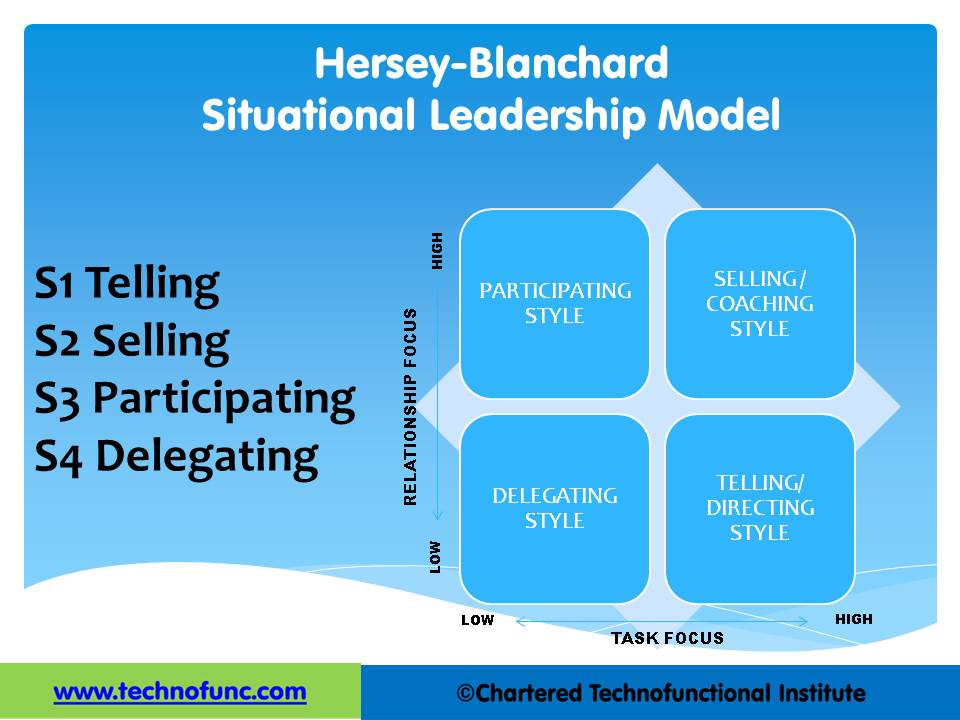- Home
- Business Processes
- Industry Knowledge
- Aerospace Industry
- Automotive Industry
- Banking Domain
- BFSI Industry
- Consumer/ FMCG Industry
- Chemicals Industry
- Engineering & Construction
- Energy Industry
- Education Domain
- Finance Domain
- Hospitality Domain
- Healthcare Industry
- Insurance Domain
- Retail Industry
- Travel and Tourism Domain
- Telecom Industry
- Leadership Skills
- eLearning
- Home
- Leadership
- Change Management
- Situational Leadership - Application
Situational Leadership - Application
Situational Leadership Theories are well known and frequently used for training leaders within organizations. Practical application is how to choose the right leadership approach for the situation. The theory emphasizes leader flexibility and advises leaders to flex their style based on the followers' needs. Leaders must adapt their leadership style to fit the prescribed task, understanding given situation/maturity of followers.
How does this Approach Works?
The situational approach is constructed around the idea that different employees are at different level of development or maturity stages which represents the relative competence and commitment of subordinates for a given task. For leaders to be effective in such situations, it is essential that they determine where subordinates are on the maturity levels and adapt their leadership styles so that their style matches with the style of the development level and the followers can be benefited by the time and energy spent by the leader on it. In a way this approach is mutually beneficial to both follower and the leader as leader can also save his time and energy by understanding the maturity levels of the follower.
It is designed to increase the frequency and quality of conversations about performance and development between managers and the people they work with so that competence is developed, commitment is gained, and talented individuals are retained. Highlighted below are the key learning objectives from this theory:
- Develop an understanding of Interaction Styles and how this model can assist in gaining a greater understanding of yourself and others
- Understand how your preferences can influence you and others
- Understand the importance of adapting own interaction style to increase effectiveness
- Be able to diagnose others’ development levels and choose the appropriate leadership style
- Know why there is no best leadership or coaching style
- Learn to use a common language for coaching and developing others
- Understand the negative impact of over supervision and under supervision on others’ performance and morale
Steps to Apply Situational Leadership Model:
1. Determine the nature of the situation.
2. Understand the nature and complexity of the task at hand
3. Evaluate the skills and the desire of the subordinates to do the task being asked to perform.
4. Identify correctly the specific developmental level at which their subordinates are functioning.
5. Adapt his or her style to the prescribed leadership style represented in the table given in the previous article.
Practical Applications of the Situational Approach:
- This theory is well known and frequently used for training leaders within organizations.
- Perceived by organizations as an effective model for training people to become effective leaders and use the skills in workplace to solve common workplace conflicts.
- Highly practical, easy to understand, sensible theory that can be applied in a variety of settings and situations.
- Provide leaders with a valuable set of guidelines that can facilitate and enhance leadership.
- Emphasizes leader flexibility and recognizes that employees act differently with different tasks and leaders need to flex their style based on the situational or followers need.
- It is an encompassing model with a wide range of applications.

Related Links
You May Also Like
-
Rensis Likert studied the patterns and styles of managers and developed four management systems known as Likert's management systems. These styles developed by him are known as Likert management systems. System 1 - Exploitative Authoritative; System 2 - Benevolent Authoritative; System 3 - Consultative and System 4 - Participative.
-
Bass's Transformational Leadership Theory
Bass Transformational Leadership Theory is based on performance beyond expectations approach which defines four elements of transformational leadership. The 4 elements described by Bernard A. Bass in 1985 are Idealised Influence, Intellectual Stimulation, Individualised Consideration, and Inspirational Motivation. This study highlights four key insights about performance beyond expectations and associated criteria to measure it.
-
The four theory of leadership was formulated after studying hundreds of leaders and the model includes four basic dimensions of effective leadership - support; interaction; facilitation; goal emphasis, and work facilitation. This model was tested as a predictor of an organization's effectiveness.
-
The development of teams is an ongoing process because the composition of the team may keep on changing. The new members may join and the old members may leave the team. The team members pass through several stages for the development of the team and there has been a lot of research to identify these stages. In this article, we discuss the common theories of team development.
-
Continuum of leadership is a leadership theory based on the relationship between the level of freedom given to the team and the level of authority used by the manager. The chosen leadership style will depend on multiple factors, including the leader's personality.
-
Process & Stages of Creativity
Creative ideas do not come just like that. There is a process to it. There are a number of techniques of creativity to support the generation of ideas but the widely practiced ones are brainstorming and lateral thinking. Most innovations are not so much the product of sudden insights as they are the result of a conscious process that often goes through multiple stages. The creative process can be divided into four stages of preparation, incubation, evaluation, and implementation.
-
Social learning theory is a theory of learning process that states that most human behavior is learned observationally through modeling. Behavior change can occur in response to leader modeling and learning occurs through the observation of rewards and punishments. The focus of this approach has been teaching leadership across formal and informal settings.
-
The great man theory of leadership is a 19th-century idea that states a person is either a natural-born leader or not. Some people are born with the necessary leadership attributes that help them create a great impact on society, politics, or the military. The theory focuses on identifying the innate qualities and characteristics possessed by great men.
-
The multiple linkage model states that leadership effectiveness is based on six variables. Multiple variables of a leader's behavior and situation have a linkage to the performance of the individual follower and work unit performance. The theory is based on the notion of the link between the organization process and managerial influence.
-
In emergent leadership, the leader is not appointed or elected to the leadership role but emerges as the leader as he is perceived by others over time as a result of the group's interaction. A person steps up as the leader over time by taking on tasks voluntarily, helping others complete their tasks better, and building consensus among groups.
Explore Our Free Training Articles or
Sign Up to Start With Our eLearning Courses

About Us
Learning
© 2023 TechnoFunc, All Rights Reserved










